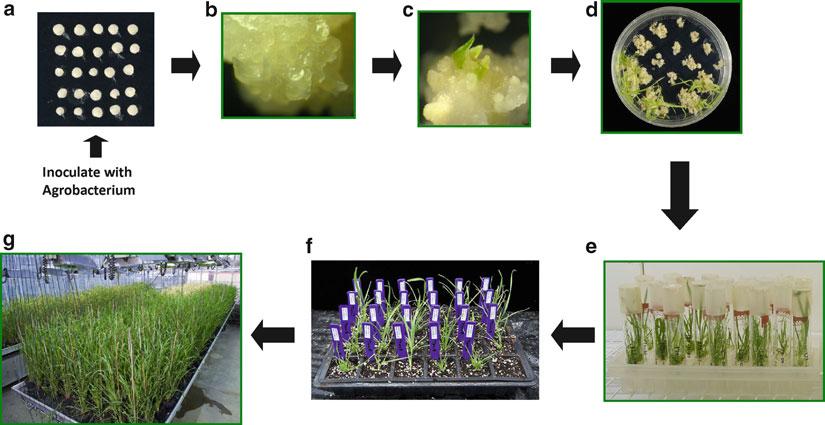Hordeum vulgare L. var. nudum Hook. f., also known as barley, it is an annual herbaceous plant belonging to the family of Gramineae and barley. It has three straight stems, up to 100 cm tall. It is suitable for growing in the cool climate of the plateau. Barley has strong cold tolerance, short growth period, high yield, early maturity, and wide adaptability. The nutrient content of barley is much higher than that of rice, wheat, and corn. It is a crop for food, feed, brewing and medicinal purposes. Barley has the characteristics of high protein content, high fiber content, high vitamins content and low fat content. It also contains cholesterol-lowering oleic acid, linoleic acid, linolenic acid, etc., and its soluble cellulose and total cellulose content are higher than those of wheat and rice. In order to further improve barley's yield, cold tolerance, drought resistance, lodging resistance, disease resistance, insect resistance, storage time, seed size of barley, many genetically modifications have been applied.

Lifeasible provides our customers with one-stop services, covering whole process including experimental design, vector construction, plasmid transformation, positive transplant screening and characterization of transgenic Hordeum vulgare L. var. nudum Hook. f., our various genetic modification services are as follows:
Gene overexpression is a common technique for studying gene function. The development and utilization of gene overexpression has brought us many conveniences to study gene function and improving the yield of target products. Through the quantitative overexpression of genes related to linoleic acid, vitamin A, amino acid and other chemical components in Hordeum vulgare L. var. nudum Hook. f., the yield of specific compounds can be increased. We could help our customers overexpress many genes including genes HvtGT and HvtHID that affect the formation of barley, drought stress response gene HtLTP1, stress resistance gene Hva1, gene HvBADH1 related to salt resistance, and many other genes related to important traits of Hordeum vulgare L. var. nudum Hook. f.
RNAi technology is widely used in the field of gene editing, it is a phenomenon of specific gene silencing mediated by double-stranded RNA (dsRNA) and involved in specific enzymes. It blocks gene expression at the transcription level and translation level. Through RNAi technology, we can achieve silencing of multiple genes in Hordeum vulgare L. var. nudum Hook. f.
Virus induced gene silencing (VIGS) is a genetic technology that inhibits the expression of endogenous genes in plants by inserting recombinant viruses into target gene segments, they can induce plant endogenous gene silencing and cause phenotypic changes, and then study the function of target genes based on phenotypic changes. The VIGS technology is a method of transient transformation and underlying molecular basis may be post-transcriptional gene silencing. Silencing and functional analysis of target genes in Hordeum vulgare L. var. nudum Hook. f. through VIGS can help our customers save time and achieve valuable information for gene functional analysis. With wealth of experience in VIGS, our scientists in Lifeasible can provide you with customized protocol for VIGS in Hordeum vulgare L. var. nudum Hook. f.
CRISPR gene knockout technology is currently the most widely used gene knockout technology, it provides us with a very powerful and convenient gene editing tool. As a leading company that has been deeply involved in the field of gene editing for many years, by CRISPR technology, we can knockout Hordeum vulgare L. var. nudum Hook. f. genes in different ways, including frameshift mutations, multiple deletion of fragments, knockout of non-coding genes, knockout of multiple copies of genes, etc.
CRISPR system has strong scalability, and this scalability can be used to develop more useful gene editing tools. we have developed many methods that can improve gene knock-in efficiency and achieve precise editing of the Hordeum vulgare L. var. nudum Hook. f. genome. For the gene knock-in process, most of CRISPR gene knock-in is done through HDR. However, NHEJ and HDR will occur at the same time due to DNA breaks. Therefore, we have developed different methods to increase the probability of HDR, thereby improving the efficiency of gene knock-in process.
CRISPR single base editing technology is a hot area of life science research today. As a company that has been cultivating gene editing technology for decades, Lifeasible could help you achieve the conversion from C to T or A to G in Hordeum vulgare L. var. nudum Hook. f. using CBE and ABE, both of which rely on the function of sgRNA recognition but without dsDNA cleavage and deaminase of the CRISPR/Cas9 system. During single base editing, the C base deaminase or A base deaminase is located at a specific position in the genome, and it catalyzes the deamination reaction of C or A at a specific position and turns it into U or I. Then it is treated as T or G in the process of DNA replication, realizing the conversion from C to T or A to G.
Sequence-specific control of gene expression on a genome-wide scale is an important approach for understanding gene functions and for engineering genetic regulatory systems. One of them is CRISPR Interference (CRISPRi). There are many ways to participate in the inhibition of gene expression. For the inhibition of Hordeum vulgare L. var. nudum Hook. f. genes, we can provide a variety of solutions, including dCas9 binding to targeted DNA and realizing Inhibition of gene transcription through steric hindrance. What's more, gene knockdown can also be achieved by recruiting a fusion protein to the start site of gene transcription.
CRISPRa technology uses the powerful capabilities of Cas9 and sgRNA to fuse or recruit multiple proteins to enhance gene transcription. For Hordeum vulgare L. var. nudum Hook. f. genes, we provide VPR technology, SAM technology and Suntag technology to allow the CRISPR system to carry more activation element and achieve a stronger activation effect after synergistic amplification.
The study of gene function has always been the core subject of biological research. The earliest genetic screening system established through forward genetics is very inefficient and has a huge workload. However, the reverse genetic screening system based on CRISPR technology can complete very low-cost mutation library construction work. The gene mutation library construction technology we provide for Hordeum vulgare L. var. nudum Hook. f. includes gene knockout library construction, gene knockdown library construction, and gene activation library construction. Moreover, single-cell sequencing is available for mutation screening.
DNA-free gene editing technology has received extensive attention from the industry in recent years. We provide DNA free Hordeum vulgare L. var. nudum Hook. f. genome editing services, including transient expression of CRISPR/Cas9 plasmid DNA, in vitro transcription of CRISPR/Cas9, and pre-assembled ribonucleic acid composed of purified Cas9 protein and sgRNAs complex. These technologies can avoid the integration of foreign DNA and genome, and reduce off-target effects. In addition, compared with traditional techniques, these techniques can avoid the use of hybridization or backcrossing to isolate CRISPR/Cas9 chimeras, so they are cheaper and have shorter experimental cycles.
Genetic Transformation Process for Hordeum vulgare L. var. nudum Hook. f.
Until now, the most advanced and widely used method for the development of genetically modified Hordeum vulgare L. var. nudum Hook. f. is Agrobacterium-mediated transformation. Briefly, the foreign target gene is transferred and integrated into Immature embryos through Agrobacterium, and then embryogenic callus was induced and generated into a whole plant.
 Figure 1. The stages of the Hordeum vulgare L. var. nudum Hook. f. transformation process. (a) Immature embryos arranged ready for inoculation, (b) embryogenic callus developing from an immature embryo, (c) the initiation of shoots on T medium, (d) regeneration of transgenic plantlets on R medium, (e) transgenic barley rooting in glass culture tubes, (f) transgenic barley just after transfer to soil, (g) transgenic barley growing to maturity in the glasshouse. (Harwood WA, et al. 2014)
Figure 1. The stages of the Hordeum vulgare L. var. nudum Hook. f. transformation process. (a) Immature embryos arranged ready for inoculation, (b) embryogenic callus developing from an immature embryo, (c) the initiation of shoots on T medium, (d) regeneration of transgenic plantlets on R medium, (e) transgenic barley rooting in glass culture tubes, (f) transgenic barley just after transfer to soil, (g) transgenic barley growing to maturity in the glasshouse. (Harwood WA, et al. 2014)
Lifeasible offers our customers with professional one-stop services, covering all steps including experimental design, vector construction, plasmid transformation, positive transplant screening and testing. Adapting to diverse purposes of different customers, multiple Agrobacterium strains (LBA4404, EHA105, C58, GV2260, GV3101), as well as commercial and customized binary vectors with variant selectable markers (Kanamycin, Hygromycin, Phosphinothricin, G418, etc.) Experts at Lifeasible obtain years of experience to solve technical problems and challenges in Hordeum vulgare L. var. nudum Hook. f. transformation. We can draw customized solution to help you research on a variety of Hordeum vulgare L. var. nudum Hook. f. genes. Our services guarantee the success of your project. For more information or any inquiry requirements, please contact Lifeasible.
Reference